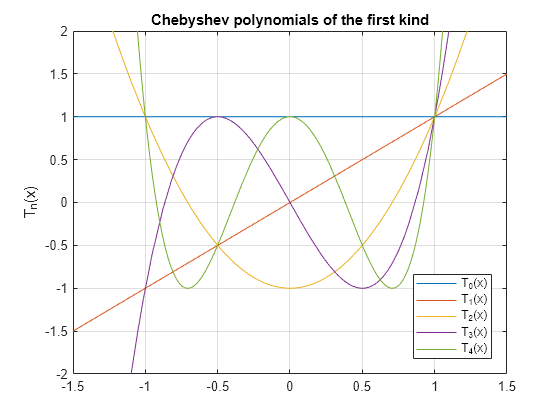chebyshevT
Chebyshev polynomials of the first kind
Syntax
Description
chebyshevT(
represents the n,x)nth degree Chebyshev polynomial of the
first kind at the point x.
Examples
First Five Chebyshev Polynomials of the First Kind
Find the first five Chebyshev polynomials of the first kind
for the variable x.
syms x chebyshevT([0, 1, 2, 3, 4], x)
ans = [ 1, x, 2*x^2 - 1, 4*x^3 - 3*x, 8*x^4 - 8*x^2 + 1]
Chebyshev Polynomials for Numeric and Symbolic Arguments
Depending on its arguments, chebyshevT
returns floating-point or exact symbolic results.
Find the value of the fifth-degree Chebyshev polynomial of the first kind at these
points. Because these numbers are not symbolic objects,
chebyshevT returns floating-point results.
chebyshevT(5, [1/6, 1/4, 1/3, 1/2, 2/3, 3/4])
ans =
0.7428 0.9531 0.9918 0.5000 -0.4856 -0.8906Find the value of the fifth-degree Chebyshev polynomial of the first kind for the
same numbers converted to symbolic objects. For symbolic numbers,
chebyshevT returns exact symbolic results.
chebyshevT(5, sym([1/6, 1/4, 1/3, 1/2, 2/3, 3/4]))
ans = [ 361/486, 61/64, 241/243, 1/2, -118/243, -57/64]
Evaluate Chebyshev Polynomials with Floating-Point Numbers
Floating-point evaluation of Chebyshev polynomials by direct
calls of chebyshevT is numerically stable. However, first
computing the polynomial using a symbolic variable, and then substituting
variable-precision values into this expression can be numerically
unstable.
Find the value of the 500th-degree Chebyshev polynomial of the first kind at
1/3 and vpa(1/3). Floating-point
evaluation is numerically stable.
chebyshevT(500, 1/3) chebyshevT(500, vpa(1/3))
ans =
0.9631
ans =
0.963114126817085233778571286718Now, find the symbolic polynomial T500 = chebyshevT(500, x),
and substitute x = vpa(1/3) into the result. This approach is
numerically unstable.
syms x T500 = chebyshevT(500, x); subs(T500, x, vpa(1/3))
ans = -3293905791337500897482813472768.0
Approximate the polynomial coefficients by using vpa, and
then substitute x = sym(1/3) into the result. This approach is
also numerically unstable.
subs(vpa(T500), x, sym(1/3))
ans = 1202292431349342132757038366720.0
Plot Chebyshev Polynomials of the First Kind
Plot the first five Chebyshev polynomials of the first kind.
syms x y fplot(chebyshevT(0:4,x)) axis([-1.5 1.5 -2 2]) grid on ylabel('T_n(x)') legend('T_0(x)','T_1(x)','T_2(x)','T_3(x)','T_4(x)','Location','Best') title('Chebyshev polynomials of the first kind')

Input Arguments
More About
Tips
chebyshevTreturns floating-point results for numeric arguments that are not symbolic objects.chebyshevTacts element-wise on nonscalar inputs.At least one input argument must be a scalar or both arguments must be vectors or matrices of the same size. If one input argument is a scalar and the other one is a vector or a matrix, then
chebyshevTexpands the scalar into a vector or matrix of the same size as the other argument with all elements equal to that scalar.
References
[1] Hochstrasser, U. W. “Orthogonal Polynomials.” Handbook of Mathematical Functions with Formulas, Graphs, and Mathematical Tables. (M. Abramowitz and I. A. Stegun, eds.). New York: Dover, 1972.
[2] Cohl, Howard S., and Connor MacKenzie. “Generalizations and Specializations of Generating Functions for Jacobi, Gegenbauer, Chebyshev and Legendre Polynomials with Definite Integrals.” Journal of Classical Analysis, no. 1 (2013): 17–33. https://doi.org/10.7153/jca-03-02.
Version History
Introduced in R2014b
See Also
chebyshevU | gegenbauerC | hermiteH | jacobiP | laguerreL | legendreP